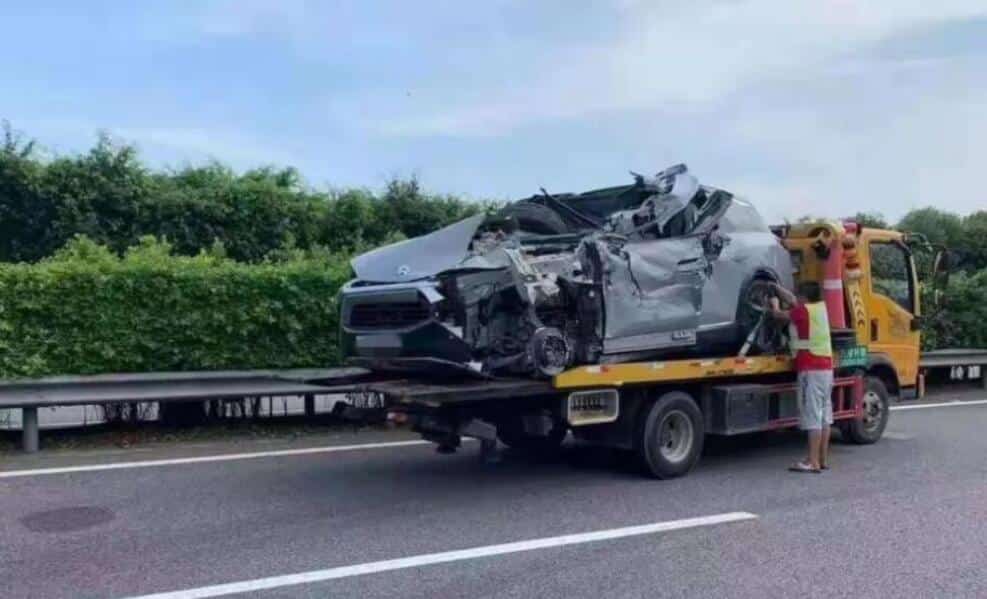Lin Wenqin, the founder of Chinese restaurant brand Meiyihao, was killed in a traffic accident last Thursday while driving an Nio ES8. His company released an obituary highlighting that the vehicle had NOP (Navigation On Pilot) on at the time, bringing that self-driving feature into the spotlight.
There is currently a lot of debate about who should be primarily responsible for the accident. So, is Nio legally responsible for the fatal ES8 crash? Autohome.com.cn interviewed some experts about this in a report on Sunday.
Nio may not be liable
Nio may not be legally liable, with the company defining its smart driving level as L2 assisted driving, giving it a lot of room for explanation, according to Han Qingwen, an associate professor at Chongqing University's School of Microelectronics and Communication Engineering.
The highest level of self-driving now on the market for sales is L2. No company is publicly selling L3 models, or L5 models, Han said, adding that no matter how car companies describe their vehicles' technology, it is currently based on the premise of L2.
Toyota's self-driving cars have exceeded L3 and can even go to L4, but they claim it's still L2 assisted driving, Han said.
Tesla CEO Elon Musk claimed that his company's products have reached L4 level, but the production models are still L2, he said.
From what is known so far, in the accident involving Nio, the driver was likely using the L2 assisted driving system as L4 autopilot, he said.
From a legal perspective, as long as Nio didn't claim its product is L3 or above, the user is primarily responsible for accidents caused by improper use, Han said.
Yu Kai, the founder of the Chinese chip company Horizon Robotics, used an example to illustrate the current relationship between Nio and vehicle owners.
"Horses have sufficient self-driving capabilities for complex situations, including perception, obstacle avoidance and path planning. However, the rider must also hold the reins in his hands in most situations and change the horse's behavior when necessary," Yu said.
If a horse hits a pedestrian, the responsibility lies first and foremost with the rider, not the horse, according to Yu.
Zhang Xiang, a researcher in the automotive industry, holds the same view.
Nio does not bear any legal responsibility inside this accident, and there is no precedent for this in China, according to Zhang.
Even in the highly watched Tesla female owner protest since April, the owner was still fully responsible and Tesla did not compensate a penny.
For now, the only way to reduce accidents is for car companies to tell owners that although they bought vehicles with L2 or L3 assisted driving, they still have to be vigilant, Zhang said.
There is no way for a third-party agency to detect such accidents because the software code, hardware systems and the internal structure of the chips in smart cars are too complex, he said.
Testing agencies can't know if the accident was triggered by a problem with the Nio's software system, decision-making layer, sensing layer or execution layer, he said.
Car companies should educate users
Experts don't think Nio should be held legally responsible, but they do believe that car companies, including Nio, should properly promote self-driving-related features and clearly inform consumers of the risks involved.
Car companies often choose an aggressive stance in their promotional strategies to highlight their product advantages in order to compete with Tesla, Han said, adding that such excessive marketing could mislead consumers.
In theory, companies should have to inform users that the vehicles they sell are equipped with L2 assisted driving features, Han said.
Some car companies are starting to advertise their products as having L3 autonomous driving capabilities, which can give consumers the illusion - that the driver doesn't need to take over the vehicle at all and that the vehicle is capable of ensuring safe driving, he argued.
It will take five to ten years to make autonomous driving deserve real human trust and reach a relationship like that of a human and a horse, according to Horizon's Yu.
None of these systems and products now can actually be considered autonomous driving, they should be considered advanced driver assistance, according to Zhu Xiaohua, senior manager of driver assistance and safety systems at the Pan-Asia Automotive Technology Center.
"Our advice to users is that no matter how intelligent the product is, as long as the vehicle is equipped with an L2 system, then they must intervene in driving the whole time and there must not be any laxity," Han stated.

